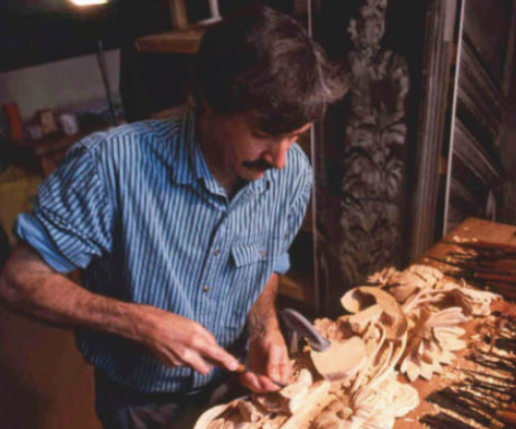大師與學徒
David Esterly, wood-carver, died on June 15th, aged 75
木雕藝術家大衛·埃斯特利于6月15日去世,享年75歲
It might happen at any time of day. David Esterly would be at his workbench, gouge in hand, when he felt the breath on his shoulder. The voice would say: "I wouldn't do it like that," or "I've made a leaf curl that way before. Why are you bothering?" He did not need to ask who it was. The man's portraits at three different stages of his life, the last plump, bewigged and comfortable, hung round his workshop in a converted barn at Barneveld, in upstate New York.
這可能發生在一天中的任何時間。大衛·埃斯特利在感覺到肩膀上的氣息的時候,會手拿圓鑿,站在自己的工作臺上。那個聲音會說:“我不會那樣做的,”或者是“我以前用這種方式制作過一個卷葉。你在擔心什么呢?”他不需要問它是誰。他的工作室位于紐約州北部巴內菲爾德,由谷倉改建而成。工作室里面掛著他人生的三個不同階段的肖像畫,最后一個階段豐滿,戴著假發,很舒服。
Grinling Gibbons, England's 17th-century genius of wood carving, was the god of the place. For ten years his admirer had been labouring to emulate his astonishingly meticulous chains and cascades of foliage, fruit, flowers, feathers and shells in the same white lime or linden wood. The tradition of such carving was long-lost. Mr Esterly, whose studies as a Fulbright scholar at Cambridge had been in Yeats and the philosopher Plotinus, hoped he had found a way to combine intellectual, moral and sensory experience into what Yeats called "unity of being".
格林林·吉本斯是英國17世紀的木雕天才,他是當地的神。十年來,他的崇拜者一直在努力模仿他制作的一系列用同樣的白石灰或椴木做成的樹葉、水果、花朵、羽毛和貝殼。這種雕刻的傳統已經很久沒見了。埃斯特利在劍橋大學做訪問學者時研究過葉芝,還有哲學家普羅提諾,他希望能找到一種方式將智力、道德和感覺體驗結合起來。他把這個稱為“存在的統一”。

There were many satisfactions in working as Gibbons had done. Standing at his workbench—not sitting, for carving involved the whole body—he would take up, with a quick flip of the hand, one of the dozens of tools spread before him. He could have done it blindfolded, knowing just where each one was. The multiplicity of blades reflected the fecundity of nature, which he would strive to reproduce with ever-more-delicate gouging.
像吉本斯那樣工作有許多令人滿意的地方。他站在工作臺上,而不是坐著,因為雕刻涉及到整個身體。他會迅速地甩一下手,拿起擺在面前的幾十件工具中的一件。他可以蒙著眼睛拿起工具,因為他知道它們都在哪里。葉片的多樣性反映了大自然的繁殖力,他會努力用更加精細的刨削來重現大自然的繁殖力。
He began each piece by stabbing down the outline on a sawn board a few inches thick, then wasting away the wood around it and modelling the form. The rearward hand, and that half of his body, propelled the tool; the forward hand, on the wood, resisted. This opposition gave him exquisite control over the blade edge. It reminded him of the empowering contrast between Dionysian impulse and Apollonian restraint; and of Hamlet, too, torn between action and thought, whose tension drove through the play.
每一件作品開始時,他先把輪廓插在一塊幾英寸厚的鋸過的木板上,然后把木板周圍的木頭削掉,做成模型。那只向后的手和他身體的那一半推動著工具;那只放在木頭上的手抵擋著。這種對立給了他對刀刃的絕妙控制。這使他想起酒神的沖動和夢神的克制之間的強烈對比;也想到哈姆雷特在行動和思想之間的左右為難,他的緊張情緒貫穿了整部戲。
譯文由可可原創,僅供學習交流使用,未經許可請勿轉載。












